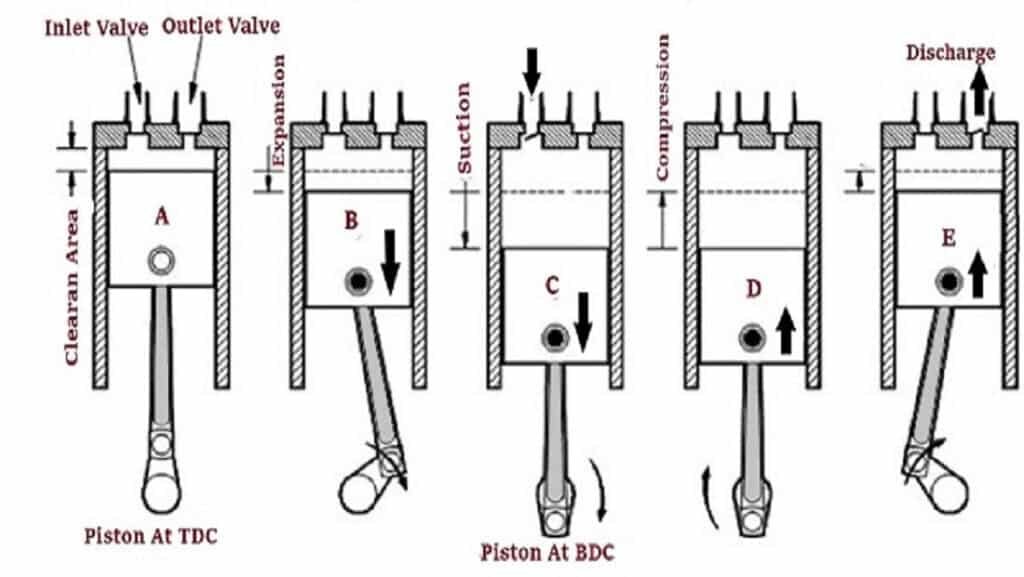A positive displacement compressor is a device used to compress gas so that it can be delivered over long distances through pipelines. These types of compressors increase the pressure of the natural gas by mechanically reducing the volume of the gas, which ultimately increases the speed and pressure of the gas in the pipeline. A positive displacement compressor usually has a piston to function normally.
Types of Positive Displacement Compressors
The positive displacement compressor has the following major types:
1. Piston compressor
Piston compressors are the oldest and most widely used type of industrial compressors. It has one or two types of functions, lubricated or oil-free, with different cylinders in different settings. Piston rings oil-free piston compressors are made of polytetrafluoroethylene (PTFE) or carbon. Or, the piston and cylinder wall lines can be like a labyrinth compressor. These units with shaft seals and base nuts, and ventilation intermediates to prevent oil transfer from the crankshaft to the compression chamber. Smaller compressors usually have permanently sealed bearing housings.
2. Rotary screw compressor
The volumetric rotary screw compressor designed in the 1930s. It has two main components: a male rotor and a female rotor that rotate in reverse, while the volume between them and the lid was reduced. Each screw element has an internal pressure ratio that depends on the discharge port’s length, screw, and shape.
For maximum efficiency, the internal pressure ratio must adjust to the required operating pressure. Modern oil-free compressors have asymmetrical screw specifications that reduce internal losses and improve energy efficiency. The external screw of this positive displacement compressor usually uses to synchronize the rotor position in reverse rotation. Since the rotors never touch, the compression chamber requires no lubrication, and the compressed air produced is completely oil-free.
Liquid-injected screw compressors use liquid lubrication in their compression chambers and generally use compressor bearings. The liquid cools and lubricates the compressor element’s moving parts, thereby cooling the compressed air and reducing inlet losses. Today oil is the most widely used liquid due to its excellent lubricating and sealing properties.
3. Tooth Compressors
The tooth compressor includes two rotors that rotate in contrary directions in the compression chamber. The compression technique consists of the suction, compression, and discharge steps. During consumption, the air is drawn into the compression chamber till the rotor blocks the drinking opening.
The air is then compressed withinside the compression chamber, which turns into smaller because the rotor rotates for the duration of compression. Finally, for the duration of compression, the opening is blocked by one of the rotors, while the inlet opens to allow fresh air to reach the opposite side of the compression chamber.
4. Scroll Compressors
A scroll compressor is usually an oil-free orbital scroll compressor, which carries a certain volume of air at a smaller volume. The compression element consists of a stator worm fixed on the housing and an eccentric worm driven by a motor. The coil installs with a 180-degree phase change to produce an air pocket with a gradual change in volume to provide radial stability of the scroll element. As the circuit rotates, the air introduces into an air pocket and gradually compressed as it moves towards the center.
5. Vane Compressors
This positive displacement compressor lubricates and operates on the same principles as compressed air expansion motors. A rotor with radially movable vane-shaped blades mounted off-center on the stator housing.
During rotation, the blades are pressed against the stator wall by centrifugal force. As the distance between the rotor and the stator increases, air sucks in. After this, air traps in the various chambers of the compressor, and its volume reduces by rotation. After this, the air expels, bypassing the blades through the outlet.
6. Root Compressors
Roots Blower is a positive displacement compressor without internal power and compression. When the compression chamber contacts the outlet, the compressed air returns to the chamber from the pressure chamber.
As a result, additional compression occurs as the compression chamber volume decreases with further rotation. Therefore, compression occurs throughout the backpressure, resulting in low efficiency and high noise levels. Root blowers are commonly used as air and vacuum transfer pumps in low-pressure applications.
Working of Positive Displacement Compressor
In all positive displacement compressors, a certain volume of gas sucks in a certain space and then compressed, which reduces the space or limited volume. At this high pressure, the gas is discharged into a pipe or container evacuation system.
Although positive displacement compressors include various configurations and geometries, the most important processing machines are reciprocating compressors and screw machines. Although there are many compressors, including the diaphragm and sliding vane compressors, most of the fundamental processes of positive gas transfer processes are reciprocating pistons and rotary screw or rotary screw devices.
Advantages of Positive Displacement Compressors
- It has a low manufacturing cost.
- Ease of manufacturing raw materials.
- It has many pricing options.
- High efficiency
- This type of compressor has a high-pressure ratio.
Disadvantages
- It requires high maintenance requires
- Not suitable for high flow rates.
- Due to residual imbalance, equivalent motors have higher component efficiency.
- These compressors have high price.
- Not suitable for dirty gases.
- The volumetric capacity range of the air compressors is limited.
- Very unreliable.


